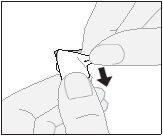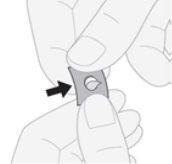

ЛАМИКТАЛ 100 мг ЖУЮЩИЕ/ДЛЯ РАСТВОРЕНИЯ ТАБЛЕТКИ

Спросите врача о рецепте на ЛАМИКТАЛ 100 мг ЖУЮЩИЕ/ДЛЯ РАСТВОРЕНИЯ ТАБЛЕТКИ

Инструкция по применению ЛАМИКТАЛ 100 мг ЖУЮЩИЕ/ДЛЯ РАСТВОРЕНИЯ ТАБЛЕТКИ
Введение
Инструкция: информация для пользователя
ЛАМИКТАЛ 100 мг жевательные/растворимые таблетки
ламотриджин
Прочитайте внимательно всю инструкцию перед началом приема этого препарата, поскольку она содержит важную информацию для вас.
- Сохраните эту инструкцию, поскольку вам может потребоваться прочитать ее снова.
- Если у вас есть какие-либо вопросы, проконсультируйтесь с вашим врачом или фармацевтом.
- Этот препарат назначен только вам, и не следует давать его другим людям, даже если у них такие же симптомы, как у вас, поскольку это может нанести им вред.
- Если вы испытываете побочные эффекты, проконсультируйтесь с вашим врачом или фармацевтом, даже если это побочные эффекты, которые не указаны в этой инструкции. См. раздел 4.
Содержание инструкции
- Что такое Ламиктал и для чего он используется
- Что вам нужно знать перед началом приема Ламиктала
- Как принимать Ламиктал
- Возможные побочные эффекты
- Хранение Ламиктала
- Содержание упаковки и дополнительная информация
1. Что такое Ламиктал и для чего он используется
Ламиктал относится к группе препаратов, называемых антиэпилептическими. Он может быть использован для лечения двух заболеваний: эпилепсиии биполярного расстройства.
Ламиктал используется для лечения эпилепсиипотому, что он блокирует сигналы в мозге, которые вызывают эпилептические приступы (атаки).
- У взрослых и детей в возрасте 13 лет и старше Ламиктал может быть использован самостоятельно или в комбинации с другими препаратами для лечения эпилепсии. Ламиктал также может быть использован в сочетании с другими препаратами для лечения приступов, вызванных заболеванием, называемым синдромом Леннокса-Гасто.
- У детей в возрасте от 2 до 12 лет Ламиктал может быть использован в комбинации с другими препаратами для лечения тех же заболеваний. Он также может быть использован без комбинации с другими препаратами для лечения типа эпилепсии, называемого типичными абсанс-приступами.
Ламиктал также используется для лечения биполярного расстройства.
Люди с биполярным расстройством (ранее называемым маниакально-депрессивнымрасстройством) испытывают радикальные изменения настроения, с периодами мании (возбуждения или эйфории), чередующихся с периодами депрессии (глубокой печали или отчаяния). У взрослых в возрасте 18 лет и старше Ламиктал может быть использован для предотвращения периодов депрессии, которые возникают при биполярном расстройстве, либо самостоятельно, либо в комбинации с другими препаратами. Не известно, как Ламиктал действует на мозг для достижения этого эффекта.
2. Что вам нужно знать перед началом приема Ламиктала
Не принимайте Ламиктал:
- если вы аллергичны(гиперчувствительны) к ламотриджину или любому другому компоненту этого препарата (перечисленному в разделе 6).
Если это ваш случай:
? Сообщите вашему врачуи не принимайте Ламиктал.
Предостережения и меры предосторожности
Будьте особенно осторожны с Ламикталом
Проконсультируйтесь с вашим врачом или фармацевтом перед началом приема Ламиктала:
- если у вас есть проблемы с почками
- если у вас когда-либо была кожная сыпьпосле приема ламотриджина или других препаратов для биполярного расстройства или эпилепсии
- если у вас есть кожная сыпь или солнечные ожогипосле приема ламотриджина и воздействия солнечного света или искусственного освещения (например, в солярии). Ваш врач проверит ваше лечение и может посоветовать вам избегать солнечного света или защищаться от него (например, использовать солнцезащитный крем и/или защитную одежду)
- если у вас когда-либо была менингитпосле приема ламотриджина (см. описание этих симптомов в разделе 4 этой инструкции: Редкие побочные эффекты)
- если вы уже принимаете препараты, содержащие ламотриджин
- если у вас есть заболевание, называемое синдромом Бругада, или другие сердечные проблемы.Синдром Бругада - это генетическое заболевание, которое вызывает аномальную электрическую активность сердца. Ламотриджин может привести к аномалиям на электрокардиограмме (ЭКГ), которые могут вызвать аритмию (нарушение сердечного ритма).
Если это ваш случай:
? Сообщите вашему врачу, который решит снизить дозу или определит, что Ламиктал не подходит вам.
Важная информация о потенциально опасных для жизни реакциях
Небольшое количество людей, принимающих Ламиктал, испытывают аллергические реакции или кожные реакции, которые потенциально могут быть опасными для жизни и могут привести к более серьезным проблемам, если не будут лечиться. Эти реакции могут включать синдром Стивенса-Джонсона (ССД), токсический эпидермальный некролиз (ТЭН) и реакцию с эозинофилией и системными симптомами (ДРЕСС). Вам необходимо знать симптомы этих реакций и быть осторожным с ними во время приема Ламиктала. Этот риск может быть связан с генетической вариацией у людей азиатского происхождения (в основном китайцев Хан и тайцев). Если вы из такого происхождения и у вас обнаружена эта генетическая вариация (HLA-B*1502), проконсультируйтесь с вашим врачом перед приемом Ламиктала.
? Прочитайте описание этих симптомов в разделе 4 этой инструкции“Потенциально опасные для жизни реакции: проконсультируйтесь с вашим врачом немедленно”.
Лимфогистиоцитарная гистиоцитоз
Были зарегистрированы случаи редкой, но очень серьезной реакции иммунной системы у пациентов, принимающих ламотриджин.
- Немедленно свяжитесь с вашим врачом или фармацевтом, если вы испытываете любой из следующих симптомов во время приема ламотриджина: лихорадка, кожная сыпь, неврологические симптомы (например, судороги или тремор, спутанность сознания, нарушения функции мозга).
Мысли о самоубийстве или причинении вреда себе
Противоэпилептические препараты используются для лечения различных заболеваний, включая эпилепсию и биполярное расстройство. Люди с биполярным расстройством могут иногда испытывать мысли о самоубийстве или причинении вреда себе. Если у вас биполярное расстройство, вы можете иметь больше шансов испытывать эти мысли в следующих ситуациях:
- когда вы начинаете лечение
- если у вас были ранее мысли о самоубийстве или причинении вреда себе
- если вам меньше 25 лет.
Если у вас есть тревожные мысли или переживания, или если вы заметили, что чувствуете себя хуже или развиваете новые симптомы во время лечения Ламикталом:
? Проконсультируйтесь с вашим врачом как можно скорее или обратитесь в ближайшую больницу.
Может быть полезно объяснить вашему близкому родственнику, опекуну или близкому другу, что вы можете испытывать депрессию или значительные изменения настроения, и попросить их прочитать эту инструкцию. Вы можете попросить их сказать вам, если они обеспокоены вашей депрессией или другими изменениями в вашем поведении.
Небольшое количество людей, которые проходили лечение противоэпилептическими препаратами, такими как Ламиктал, также испытывали мысли о самоубийстве или причинении вреда себе. Если у вас когда-либо были такие мысли, немедленно свяжитесь с вашим врачом.
Если вы принимаете Ламиктал для эпилепсии
Приступы при некоторых типах эпилепсии могут иногда ухудшаться или возникать чаще во время приема Ламиктала. Некоторые пациенты могут испытывать тяжелые приступы, которые могут вызвать серьезные проблемы со здоровьем. Если приступы возникают чаще или если вы испытываете тяжелые приступы во время приема Ламиктала:
? Обратитесь к врачу немедленно.
Не следует назначать Ламиктал детям младше 18 лет для лечения биполярного расстройства. Препараты, используемые для лечения депрессии и других проблем со здоровьем, увеличивают риск мыслей и поведения, связанного с самоубийством, у детей и подростков младше 18 лет.
Другие препараты и Ламиктал
Сообщите вашему врачу или фармацевту, если вы принимаете, недавно принимали или можете приниматьлюбой другой препарат, включая препараты на основе растений или другие препараты, приобретенные без рецепта.
Ваш врач должен знать, принимаете ли вы другие препараты для лечения эпилепсии или проблем со здоровьем. Это необходимо для обеспечения того, чтобы вы принимали правильную дозу Ламиктала. Среди этих препаратов включены:
- окскарбазепин, фельбамат, габапентин, леветирацетам, прегабалин, топираматили зонисамид, используемые для лечения эпилепсии
- литий, оланзапин или арипипразол, используемые для лечения проблем со здоровьем
- бупропион, используемый для лечения проблем со здоровьемили для прекращения курения
- парацетамол, используемый для лечения болии лихорадки.
?Сообщите вашему врачу, если вы используете любой из этих препаратов.
Некоторые препараты взаимодействуют с Ламикталом или увеличивают вероятность побочных эффектов. Среди них включены:
- вальпроат, используемый для лечения эпилепсиии проблем со здоровьем
- карбамазепин, используемый для лечения эпилепсиии проблем со здоровьем
- фенитоин, примидонили фенобарбитал, используемые для лечения эпилепсии
- рисперидон, используемый для лечения проблем со здоровьем
- рифампицин, который является антибиотиком
- препараты, используемые для лечения ВИЧ-инфекции(комбинация лопинавира и ритонавира или атазанавира и ритонавира)
- гормональные контрацептивы, такие как противозачаточные таблетки(см. ниже).
?Сообщите вашему врачу, если вы используете любой из этих препаратов или если вы начинаете или прекращаете использование любого из этих препаратов.
Гормональные контрацептивы (например, противозачаточные таблетки) могут повлиять на действие Ламиктала.
Ваш врач может порекомендовать вам использовать определенный гормональный контрацептив или другой метод контрацепции, такой как презервативы, диафрагма или ВМС. Если вы принимаете гормональный контрацептив, такой как противозачаточные таблетки, ваш врач может провести анализ крови для проверки уровня Ламиктала. Если вы используете гормональный контрацептив или планируете начать использовать его:
? Проконсультируйтесь с вашим врачом, поскольку он укажет вам наиболее подходящие методы контрацепции для вас.
Ламиктал также может повлиять на действие гормональных контрацептивов, хотя это маловероятно, что он уменьшит их эффективность. Если вы используете гормональный контрацептив и заметили изменения в вашем менструальном цикле, такие как межменструальное кровотечение или выделения между менструациями:
?Сообщите вашему врачу. Это могут быть признаки того, что Ламиктал влияет на действие вашего контрацептива.
Беременность и лактация
? Если вы беременны, думаете, что можете быть беременной или планируете стать беременной, проконсультируйтесь с вашим врачом или фармацевтом перед использованием этого препарата.
- Не прекращайте лечение без консультации с вашим врачом. Это особенно важно, если у вас эпилепсия.
- Беременность может изменить эффективность лечения Ламикталом, поэтому вам может потребоваться анализ крови и коррекция дозы.
- Если Ламиктал принимается в течение первых 3 месяцев беременности, может быть небольшое увеличение риска врожденных дефектов, включая расщепление губы и/или нёба.
- Ваш врач может порекомендовать вам принимать добавки фолиевой кислоты, если вы планируете стать беременной и во время беременности.
?Если вы кормите грудью или планируете начать кормить грудью, проконсультируйтесь с вашим врачом или фармацевтом перед использованием этого препарата.Активное вещество Ламиктала проникает в грудное молоко и может повлиять на вашего ребенка. Ваш врач обсудит с вами риски и преимущества кормления грудью во время приема Ламиктала и будет проводить периодические осмотры вашего ребенка, если вы решите начать кормить грудью, поскольку он может испытывать сонливость, кожную сыпь или плохой набор веса. Сообщите вашему врачу, если вы заметите любой из этих симптомов у вашего ребенка.
Вождение и использование машин
Ламиктал может вызывать головокружение и двоение в глазах.
? Не驾驶айте транспортные средства и не используйте машины, если вы не уверены, что не испытываете этих эффектов.
Если у вас эпилепсия, проконсультируйтесь с вашим врачом о возможности вождения или использования машин.
Важная информация о некоторых компонентах Ламиктала
Этот препарат содержит менее 1 ммоль натрия (23 мг) на таблетку; это означает, что он практически не содержит натрия.
3. Как принимать Ламиктал
Следуйте точно инструкциям по применению этого лекарства, указанным вашим врачом или фармацевтом. В случае сомнений проконсультируйтесь с вашим врачом или фармацевтом.
Какая доза Ламиктала принимать
Может потребоваться некоторое время, чтобы врач определил наиболее подходящую для вас дозу Ламиктала. Доза, которую вам необходимо принимать, будет зависеть от:
- вашего возраста
- приема Ламиктала с другими лекарствами
- наличия у вас проблем с печенью или почками.
Врач назначит вам низкую начальную дозу и постепенно увеличит ее в течение нескольких недель до достижения наиболее подходящей для вас дозы (называемой эффективной дозой). Никогда не принимайте больше Ламиктала, чем указано вашим врачом.
Обычно эффективная доза Ламиктала для взрослых и детей старше 13 лет составляет от 100 мг до 400 мг в день.
Для детей в возрасте от 2 до 12 лет эффективная доза зависит от их веса, обычно от 1 мг до 15 мг на килограмм веса ребенка, до максимальной поддерживающей дозы 200 мг в день.
Не рекомендуется использовать Ламиктал у детей младше 2 лет.
Как принимать дозу Ламиктала
Принимайте свою дозу Ламиктала один или два раза в день, как посоветует ваш врач. Их можно принимать с пищей или без нее.
- Всегда принимайте полную дозу, назначенную врачом. Никогда не принимайте часть таблетки.
Ваш врач может посоветовать вам начать или прекратить прием других лекарств, в зависимости от проблемы, по которой вы проходите лечение, и от того, как вы реагируете на лечение.
Жевательные/растворимые таблетки Ламиктала можно проглотить целиком с небольшим количеством воды, разжевать или добавить воду, чтобы растворить их. Никогда не принимайте только часть жидкости.
Вынимание таблетки:
Эти таблетки поставляются в специальной упаковке, чтобы предотвратить доступ к ним детей.
Каждая единица блистера имеет номер. Возьмите каждую таблетку в порядке, начиная с таблетки № 1.
- Отделите таблетку: разорвите по линии разрыва, чтобы отделить одну из единиц блистера.

- Снимите внешний слой: начиная с угла, поднимите и удалите ламину, покрывающую единицу.

- Выньте таблетку: нажмите мягко на одну из сторон таблетки, чтобы вынуть ее через ламину.

Жевание таблетки:
Возможно, что при жевании таблетки вам понадобится выпить немного воды, чтобы помочь таблетке раствориться во рту. После проглатывания выпейте еще немного воды, чтобы убедиться, что вы приняли все лекарство.
Для растворения лекарства:
- поместите таблетку в стакан с достаточным количеством воды, чтобы покрыть всю таблетку
- встряхните, чтобы растворить, или подождите, пока таблетка полностью не растворится
- выпейте все жидкость
- добавьте немного больше воды в стакан и выпейте, чтобы убедиться, что в стакане не осталось лекарства.
Если вы приняли больше Ламиктала, чем следует
?В случае передозировки или случайного приема обратитесь к врачу, фармацевту или позвоните в Центр токсикологической информации, телефон: 91 562 04 20, указав лекарство и количество, принятое.
Если вы приняли больше Ламиктала, чем следует, вы можете быть более склонны к тяжелым побочным эффектам, которые могут быть смертельными.
Человек, принявший слишком много Ламиктала, может испытывать некоторые из этих симптомов:
- быстрые и неконтролируемые движения глаз (нистагмус)
- неуклюжесть и потеря координации, влияющие на равновесие (атаксия)
- изменения сердечного ритма (обычно обнаруживаемые с помощью ЭКГ)
- потеря сознания, судороги или кома.
Если вы пропустили прием дозы Ламиктала
?Не принимайте двойную дозу, чтобы компенсировать пропущенные дозы.Принимайтеследующую дозу в обычное время.
В случае пропуска нескольких доз Ламиктала
?Спросите у вашего врача совета о том, как снова начать лечение. Это важно.
Не прекращайте прием Ламиктала без консультации с врачом
Вы должны принимать Ламиктал в течение всего периода, который рекомендует ваш врач. Не прекращайте его прием, если только ваш врач не посоветует вам это.
Если вы принимаете Ламиктал для лечения эпилепсии
Чтобы прекратить прием Ламиктала, важно постепенно уменьшить дозув течение примерно 2 недель. Если вы прекратите прием Ламиктала внезапно, вы можете снова испытывать симптомы эпилепсии или заболевание может ухудшиться.
Если вы принимаете Ламиктал для лечения биполярного расстройства
Ламиктал может потребовать некоторое время, чтобы подействовать, поэтому вряд ли вы сразу почувствуете себя лучше. Если вы прекратите прием Ламиктала, вам не нужно постепенно уменьшать дозу. Однако перед прекращением лечения Ламикталом вы должны проконсультироваться с вашим врачом.
4. Возможные побочные эффекты
Как и все лекарства, это лекарство может вызывать побочные эффекты, хотя не все люди испытывают их.
Реакции, потенциально угрожающие жизни: обратитесь к врачу немедленно.
Небольшое количество людей, принимающих Ламиктал, испытывают аллергические реакции или кожные реакции, которые потенциально могут угрожать их жизни и могут привести к более серьезным проблемам, если не будут behandены.
Более вероятно, что эти симптомы появятся в первые месяцы лечения Ламикталом, особенно если начальная доза слишком высока или если увеличение дозы слишком быстрое, или если вы принимаете Ламиктал с другим лекарством, называемым валпроатом. Некоторые из этих симптомов более часто встречаются у детей, поэтому родители должны обращать на них особое внимание.
Симптомы этих реакций включают:
- кожные высыпания или покраснение, которые могут привести к кожным реакциям, которые могут быть тяжелыми или иногда потенциально смертельными, включая высыпание с поражениями в виде мишени (эритема многоформная), распространенное высыпание с пузырями и отслоением кожи, которое возникает особенно вокруг рта, носа, глаз и гениталий (синдром Стивенса-Джонсона), отслоение кожи на обширной области (токсическая эпидермальная некролиз) или кожная сыпь с поражением печени, крови и других органов (реакция с эозинофилией и системными симптомами, также известная как синдром гиперчувствительности (DRESS))
- язвы во рту, горле, носу или гениталиях
- боль во рту или красные, опухшие глаза(конъюнктивит)
- повышенная температура(лихорадка), симптомы, похожие на грипп или сонливость (сopor)
- отек вокруг лицаили воспалениелимфатических узловна шее, в подмышках или паху
- кровотечение или неожиданное появление синяков, или что пальцы становятся синими
- боль в горлеили более частые инфекции (например, простуда)
- увеличение уровня печеночных ферментов в анализах крови
- увеличение количества определенного типа белых кровяных клеток (эозинофилов)
- увеличенные лимфатические узлы
- поражение органов, включая печень и почки.
Во многих случаях эти симптомы могут быть признаками менее тяжелых побочных эффектов. Но вы должны быть осведомлены, что они потенциально могут угрожать жизнии могут привести к более серьезным проблемам,таким как отказ органов, если не будут behandены. Если вы заметите любой из этих симптомов:
?Обратитесь к врачу немедленно. Ваш врач решит, следует ли провести тесты для оценки функции печени, почек или крови, и может посоветовать вам прекратить лечение Ламикталом. Если вы развили синдром Стивенса-Джонсона или токсическую эпидермальную некролиз, ваш врач посоветует вам никогда больше не принимать ламотриджин.
Лимфогистиоцитоз гемофагоцитарный (ЛГГ)(см. раздел 2. Что вам нужно знать перед началом приема Ламиктала).
Очень частые побочные эффекты
Эти побочные эффекты встречаются у более 1 из 10человек:
- головная боль
- кожная сыпь.
Частые побочные эффекты
Эти побочные эффекты встречаются у до 1 из 10человек:
- агрессивность или раздражительность
- чувство сонливости или сонливости
- чувство головокружения
- спазмы или дрожь
- трудности со сном (бессонница)
- чувство беспокойства
- диарея
- сухость во рту
- тошнота или рвота
- чувство усталости
- боль в спине, суставах или других местах.
Редкие побочные эффекты
Эти побочные эффекты встречаются у до 1 из 100человек:
- неуклюжесть и потеря координации (атаксия)
- двойное зрение или размытое зрение
- уменьшение количества волос или необычная потеря волос (алопеция)
- кожная сыпь или загар после воздействия солнца или искусственного света (фотосенсибилизация).
Очень редкие побочные эффекты
Эти побочные эффекты встречаются у до 1 из 1000человек:
- кожная реакция, характеризующаяся красными пятнами, концентрическими на коже, которые могут напоминать "мишень"; то есть, с красным центром, окруженным более светлыми красными кольцами (эритема многоформная)
- кожная реакция, которая может угрожать жизни (синдром Стивенса-Джонсона) (см. также информацию в начале раздела 4)
- комплекс симптомов, включая: лихорадку, тошноту, рвоту, головную боль, жесткость шеи и повышенную чувствительность к яркому свету.
Это может быть вызвано воспалением оболочек, покрывающих мозг и спинной мозг (менингит). Эти симптомы обычно исчезают, когда лечение прекращается. Однако, если симптомы продолжаются или ухудшаются, обратитесь к врачу
- быстрые и неконтролируемые движения глаз (нистагмус)
- зуд в глазах, с выделением и гнойными выделениями на веках (конъюнктивит).
Очень редкие побочные эффекты
Эти побочные эффекты встречаются у до 1 из 10 000человек:
- кожная реакция, которая может угрожать жизни (токсическая эпидермальная некролиз) (см. также информацию в начале раздела 4)
- фармакологическая реакция с эозинофилией и системными симптомами (DRESS) (см. также информацию в начале раздела 4)
- повышенная температура (лихорадка) (см. также информацию в начале раздела 4)
- отек вокруг лица (отек) или воспаление лимфатических узлов (лимфаденопатия) (см. также информацию в начале раздела 4)
- изменения функции печени, которые могут быть обнаружены в анализах крови, или отказ печени (см. также информацию в начале раздела 4)
- тяжелое нарушение свертываемости крови, которое может вызвать кровотечение или неожиданное появление синяков (диссеминированная внутрисосудистая коагуляция) (см. также информацию в начале раздела 4)
- лимфогистиоцитоз гемофагоцитарный (ЛГГ) (см. раздел 2. Что вам нужно знать перед началом приема Ламиктала)
- изменения, которые могут быть обнаружены в анализах крови, включая уменьшение количества красных кровяных клеток (анемия), уменьшение количества белых кровяных клеток (лейкопения, нейтропения, агранулоцитоз), уменьшение количества тромбоцитов (тромбоцитопения), уменьшение количества всех типов кровяных клеток (панцитопения) и нарушение костного мозга, называемое апластической анемией
- галлюцинации (слышать или видеть вещи, которые не существуют на самом деле)
- спутанность сознания
- чувство неуверенности или нестабильности при движении
- повторяющиеся движения или звуки, или неkontролируемые слова (тики), неконтролируемые мышечные спазмы, поражающие глаза, голову и торс (хореоатетоз), или другие необычные движения, такие как подергивания, спазмы или жесткость
- у людей с эпилепсией, более частые приступы
- у людей с болезнью Паркинсона, ухудшение симптомов
- реакция, подобная системной красной волчанке (симптомы могут включать: боль в спине или суставах, которые могут быть сопровождены лихорадкой и/или общим заболеванием).
Другие побочные эффекты
Другие побочные эффекты были зарегистрированы у небольшого количества людей, но их точная частота неизвестна:
- были сообщены изменения костей, включая остеопению и остеопороз (уменьшение толщины костей) и переломы. Обратитесь к врачу или фармацевту, если вы принимали противоэпилептические препараты в течение длительного времени, если у вас есть история остеопороза или если вы принимаете стероиды
- воспаление почки (нефрит) или воспаление почки и глаза (синдром острого интерстициального нефрита и увеита)
- кошмары
- уменьшение иммунитета из-за уменьшения уровня антител, называемых иммуноглобулинами, в крови, которые помогают защитить от инфекции
- узлы или красные пятна на коже (псевдолимфома).
Сообщение о побочных эффектах
Если вы испытываете любой побочный эффект, обратитесь к врачу или фармацевту, даже если это возможный побочный эффект, который не указан в этом листке. Вы также можете сообщить об этом напрямую через систему фармакологического мониторинга: www.notificaRAM.es. Сообщая о побочных эффектах, вы можете способствовать предоставлению более полной информации о безопасности этого лекарства.
5. Хранение Ламиктала
Храните это лекарство в недоступном для детей месте.
Не используйте это лекарство после даты истечения срока годности, указанной на блистере, упаковке или банке. Дата истечения срока годности - последний день месяца, указанного.
Ламиктал не требует специальных условий хранения.
Лекарства не должны выбрасываться в канализацию или мусор. Сдайте упаковку и лекарства, которые вам больше не нужны, в аптеку. Если у вас есть сомнения, спросите у фармацевта, как избавиться от упаковки и лекарств, которые вам больше не нужны. Таким образом, вы поможете защитить окружающую среду.
6. Содержание упаковки и дополнительная информация
Состав Ламиктала 100 мг жевательных/растворимых таблеток
Активное вещество - ламотриджин. Каждая жевательная/растворимая таблетка содержит 100 мг ламотриджина.
Другие компоненты: карбонат кальция, гидроксипропилцеллюлоза с низким grado замещения, силикат алюминия и магния, карбоксиметилкрахмал натрия (тип А) из картофеля, повидон K30, сакерин натрия, стеарат магния, ароматизатор черной смородины.
Внешний вид продукта и содержание упаковки Ламиктала жевательных/растворимых таблеток
Жевательные/растворимые таблетки Ламиктала белые или почти белые и могут быть слегка пятнистыми. Таблетки имеют запах черной смородины.
Жевательные/растворимые таблетки Ламиктала 100 мг квадратные с закругленными углами. Таблетки маркированы "GSCL7" на одной стороне и "100" на другой. Каждая упаковка содержит блистеры по 10, 14, 28, 30, 42, 50, 56, 60, 90, 98, 100, 196 или 200 таблеток.
Возможно, что не все размеры упаковок будут продаваться.
Владелец разрешения на маркетинг и ответственный за производство
Владелец разрешения на маркетинг:
GlaxoSmithKline, S.A.
P.T.M. C/ Severo Ochoa, 2
28760 Tres Cantos (Мадрид)
Тел: +34 900 202 700
Ответственный за производство:
Delpharm Poznan Spólka Akcyjnaul. Grunwaldzka 18960-322 PoznanПольша
Это лекарство разрешено в государствах-членах Европейского экономического пространства под следующими названиями:
Австрия Ламиктал | Бельгия Ламиктал | Болгария Ламиктал |
Хорватия Ламиктал | Кипр Ламиктал | Чехия Ламиктал |
Дания Ламиктал | Эстония Ламиктал | Финляндия Ламиктал |
Франция Ламиктал | Германия Ламиктал | Греция Ламиктал |
Венгрия Ламиктал | Исландия Ламиктал | Ирландия Ламиктал |
Италия Ламиктал | Латвия Ламиктал | Литва Ламиктал |
Люксембург Ламиктал | Мальта Ламиктал | Нидерланды Ламиктал |
Норвегия Ламиктал | Польша Ламитрин Ламитрин С | Португалия Ламиктал |
Румыния Ламиктал | Словакия Ламиктал | Словения Ламиктал |
Испания Ламиктал | Швеция Ламиктал |
Дата последнего пересмотра этого листка:апрель 2024.
Подробная и актуальная информация о этом лекарстве доступна на сайте Агентства по лекарственным средствам и медицинским изделиям Испании (AEMPS) http://www.aemps.gob.es/

Сколько стоит ЛАМИКТАЛ 100 мг ЖУЮЩИЕ/ДЛЯ РАСТВОРЕНИЯ ТАБЛЕТКИ в Испании в 2025 году?
Средняя цена на ЛАМИКТАЛ 100 мг ЖУЮЩИЕ/ДЛЯ РАСТВОРЕНИЯ ТАБЛЕТКИ в декабрь, 2025 года составляет около 26.35 евро. Финальная стоимость может зависеть от региона, конкретной аптеки и рецептурного статуса. Для точной информации лучше проверить онлайн или в ближайшей аптеке.
- Страна регистрации
- Средняя цена в аптеках26.35 EUR
- Активное вещество
- Требуется рецептДа
- Производитель
- Информация носит справочный характер и не является медицинской рекомендацией. Перед приемом любых препаратов проконсультируйтесь с врачом. Oladoctor не несет ответственности за медицинские решения, принятые на основе этого контента.
- Аналоги ЛАМИКТАЛ 100 мг ЖУЮЩИЕ/ДЛЯ РАСТВОРЕНИЯ ТАБЛЕТКИФорма выпуска: ЖЕВАТЕЛЬНАЯ ТАБЛЕТКА, 100 мг ламотригинаАктивное вещество: ламотриджинПроизводитель: Glaxosmithkline S.A.Требуется рецептФорма выпуска: ЖЕВАТЕЛЬНАЯ ТАБЛЕТКА, 200 мг ламотригинаАктивное вещество: ламотриджинПроизводитель: Glaxosmithkline S.A.Требуется рецептФорма выпуска: ЖЕВАТЕЛЬНАЯ ТАБЛЕТКА, 25 мг ламотригинаАктивное вещество: ламотриджинПроизводитель: Glaxosmithkline S.A.Требуется рецепт
Аналоги ЛАМИКТАЛ 100 мг ЖУЮЩИЕ/ДЛЯ РАСТВОРЕНИЯ ТАБЛЕТКИ в других странах
Лучшие аналоги с тем же действующим веществом и терапевтическим эффектом.
Аналог ЛАМИКТАЛ 100 мг ЖУЮЩИЕ/ДЛЯ РАСТВОРЕНИЯ ТАБЛЕТКИ в Польща
Аналог ЛАМИКТАЛ 100 мг ЖУЮЩИЕ/ДЛЯ РАСТВОРЕНИЯ ТАБЛЕТКИ в Україна
Врачи онлайн по ЛАМИКТАЛ 100 мг ЖУЮЩИЕ/ДЛЯ РАСТВОРЕНИЯ ТАБЛЕТКИ
Консультация по дозировке, побочным эффектам, взаимодействиям, противопоказаниям и продлению рецепта на ЛАМИКТАЛ 100 мг ЖУЮЩИЕ/ДЛЯ РАСТВОРЕНИЯ ТАБЛЕТКИ – по решению врача и с учетом местных правил.







